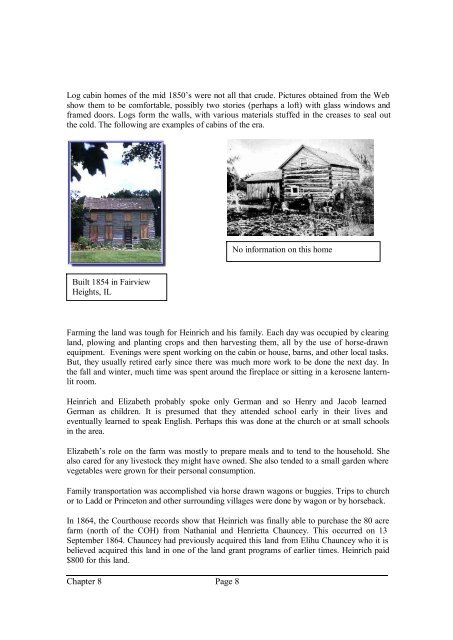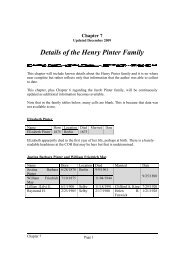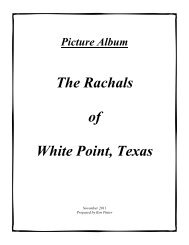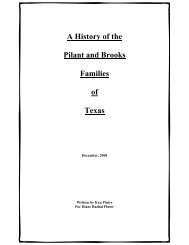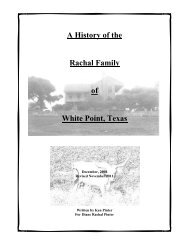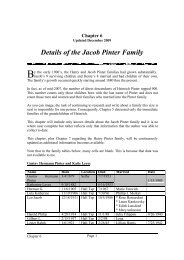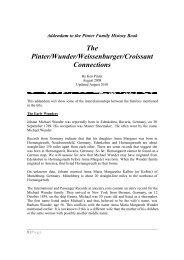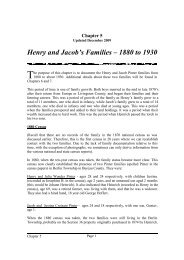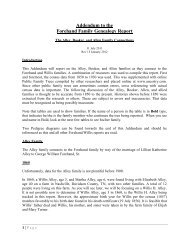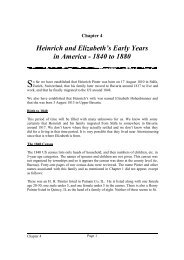Early Farm Life in Bureau County, Illinois, and ... - New Page 1
Early Farm Life in Bureau County, Illinois, and ... - New Page 1
Early Farm Life in Bureau County, Illinois, and ... - New Page 1
You also want an ePaper? Increase the reach of your titles
YUMPU automatically turns print PDFs into web optimized ePapers that Google loves.
Log cab<strong>in</strong> homes of the mid 1850’s were not all that crude. Pictures obta<strong>in</strong>ed from the Web<br />
show them to be comfortable, possibly two stories (perhaps a loft) with glass w<strong>in</strong>dows <strong>and</strong><br />
framed doors. Logs form the walls, with various materials stuffed <strong>in</strong> the creases to seal out<br />
the cold. The follow<strong>in</strong>g are examples of cab<strong>in</strong>s of the era.<br />
No <strong>in</strong>formation on this home<br />
Built 1854 <strong>in</strong> Fairview<br />
Heights, IL<br />
<strong>Farm</strong><strong>in</strong>g the l<strong>and</strong> was tough for He<strong>in</strong>rich <strong>and</strong> his family. Each day was occupied by clear<strong>in</strong>g<br />
l<strong>and</strong>, plow<strong>in</strong>g <strong>and</strong> plant<strong>in</strong>g crops <strong>and</strong> then harvest<strong>in</strong>g them, all by the use of horse-drawn<br />
equipment. Even<strong>in</strong>gs were spent work<strong>in</strong>g on the cab<strong>in</strong> or house, barns, <strong>and</strong> other local tasks.<br />
But, they usually retired early s<strong>in</strong>ce there was much more work to be done the next day. In<br />
the fall <strong>and</strong> w<strong>in</strong>ter, much time was spent around the fireplace or sitt<strong>in</strong>g <strong>in</strong> a kerosene lanternlit<br />
room.<br />
He<strong>in</strong>rich <strong>and</strong> Elizabeth probably spoke only German <strong>and</strong> so Henry <strong>and</strong> Jacob learned<br />
German as children. It is presumed that they attended school early <strong>in</strong> their lives <strong>and</strong><br />
eventually learned to speak English. Perhaps this was done at the church or at small schools<br />
<strong>in</strong> the area.<br />
Elizabeth’s role on the farm was mostly to prepare meals <strong>and</strong> to tend to the household. She<br />
also cared for any livestock they might have owned. She also tended to a small garden where<br />
vegetables were grown for their personal consumption.<br />
Family transportation was accomplished via horse drawn wagons or buggies. Trips to church<br />
or to Ladd or Pr<strong>in</strong>ceton <strong>and</strong> other surround<strong>in</strong>g villages were done by wagon or by horseback.<br />
In 1864, the Courthouse records show that He<strong>in</strong>rich was f<strong>in</strong>ally able to purchase the 80 acre<br />
farm (north of the COH) from Nathanial <strong>and</strong> Henrietta Chauncey. This occurred on 13<br />
September 1864. Chauncey had previously acquired this l<strong>and</strong> from Elihu Chauncey who it is<br />
believed acquired this l<strong>and</strong> <strong>in</strong> one of the l<strong>and</strong> grant programs of earlier times. He<strong>in</strong>rich paid<br />
$800 for this l<strong>and</strong>.<br />
Chapter 8 <strong>Page</strong> 8


